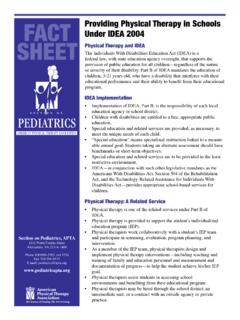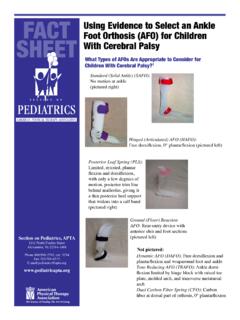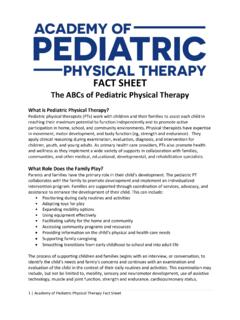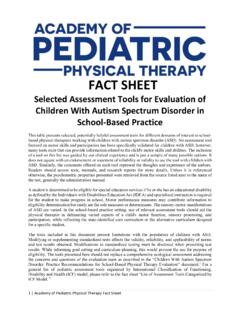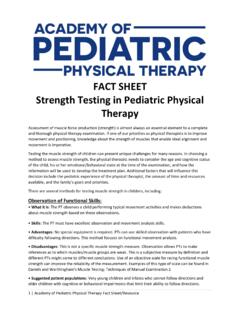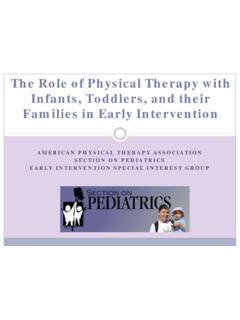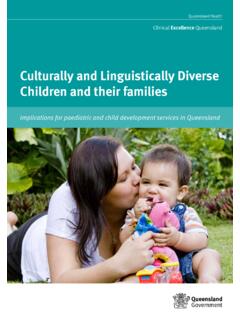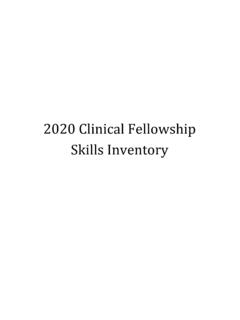Transcription of Motor Development Variations Across Cultures
1 1 | Academy of Pediatric Physical Therapy Fact Sheet/Resource RESOURCE/FACT SHEET Motor Development Variations Across Cultures Implications for culturally Competent and Family-Centered Pediatric Care WHAT IS CULTURE? The United States Department of Health and Human services Office of Minority Health defines culture as integrated patterns of human behavior that include the language, thoughts, communications, actions, customs, beliefs, values, and institutions of racial, ethnic, religious, or social groups. 1 Culture has also been defined as the learned and shared beliefs, values, and life ways of a designated or particular group which are generally transmitted intergenerationally and influence one's thinking and action modes.
2 2 Culture is one of the many variables known to affect Motor Development . These variables include but are not limited to climate,3 sex,4 early postural experience,5,6 socioeconomic status,7 nutrition,8 physical growth,9 childrearing practices,10 and parental Because the concept of culture is multifaceted, this fact sheet will focus on cultural Variations in Motor Development as they relate to culture-based caregiving practices, routines, and parental beliefs Across different racial/ethnic groups. WHY IS THIS IMPORTANT? The child population of the USA is expected to experience the majority minority crossover in By 2030, children from racial/ethnic minorities will account for more than half of the US population under the age of 18 By 2060, 64% of children in the USA will belong to racial and ethnic minorities compared with 56% for the total population, and nearly one in five of the nation s total population will be As the US child population continues to grow increasingly diverse.
3 Pediatric physical therapists must carefully consider the child/family s cultural background and caregiving practices when assessing infants and children, establishing a plan of care, developing goals, and administering skilled intervention. CULTURE AND Motor Development Evidence from cross-cultural research has challenged the assumption that Motor Development follows a fixed and predictable Culture-based Variations in gross Motor Development have been 2 | Academy of Pediatric Physical Therapy Fact Sheet/Resource documented in populations around the world. The following examples illustrate some of these differences and encourage a more flexible view of Motor Development milestones.
4 These examples are not all-inclusive of the current body of cross-cultural studies and should not be used to make generalizations regarding a family s caregiving practices or expectations regarding their child s Development . *not all-inclusive of cross-cultural research literature IMPLICATIONS FOR PHYSICAL THERAPISTS Infants from certain cultural groups may follow unique Motor Development trajectories due to culture-specific caregiving practices or cultural Using standardized Motor Development screening and assessment tools to evaluate the Motor Development of children in Cultures other than those in which the normative samples were established may lead to misinterpretation of results and erroneous labeling of young children as WHAT?
5 DOCUMENTED REASONS WHY Higher percentage of independent sitting in 5-month-old infants living in Cameroon and Kenya compared to 5-month-old infants living in Argentina, Italy, South Korea, and the US15 Emphasis on upright positioning and opportunities for practicing sitting during daily activities15 Gross Motor acceleration in infants living in Jamaica,16,17 Kenya,18,19 Mali,20 Nigeria,21 and Uganda22,23 - Culture-based handling practices: (1) aggressive massage applied to infants with low tone11 (2) traction applied to infants head and limbs for stretching11 - Culture-based positioning practices.
6 (1) infants living in Africa carried in slings with little to no head support while mothers work in the field14 (2) African infants propped into sitting and walking positions by parents19,20 - Cultural belief/value that walking promotes a child s integration into their society and fosters interdependence11 Skipping of crawling by infants living in Jamaica16,17 Cultural belief/perception that crawling is primitive and ,17 In contrast, crawling on hands and knees is valued in European and American cultural groups as it promotes early independence with mobility24 Delayed onset of gross Motor milestones in infants living in China and Japan as compared to infants living in Western countries25,26 - Predominance of supine positioning during wakeful moments in Eastern Asian countries25,26,27 - Practice of sandbags for infant toileting in Northern China.
7 Infants spend more than 16 hours per day lying supine inside a small sleeping bag filled with fine sand26 - Infants tend to be dressed in heavy clothing, which may limit movement exploration28 Infants living in Hong Kong learn to roll supine to prone before they roll from prone to supine, the opposite of what is observed in Western cultures27 Preference for supine positioning during the day, resulting in decreased opportunities for practice of antigravity postural control27 Slowest rate of human Development in The Ache group in Paraguay, a hunter-gatherer society11,14 Independent mobility is perceived as dangerous and is therefore discouraged by parents11,14 3 | Academy of Pediatric Physical Therapy Fact Sheet/Resource developmentally delayed or early achieving.
8 29 o New population norms and cross-cultural adaptations for commonly used standardized Motor Development screening and assessment tools are available for many cultural It is common for families to retain their culture-specific caregiving practices when they immigrate to a different country. A child born in the US to parents raised in another country may be raised using culture-specific handling and positioning practices of the parents culturally COMPETENT CARE AND FAMILY-CENTERED PEDIATRIC CARE: PUT ON YOUR THINKING CAP! CULTURAL COMPETENCY RESOURCES APTA Vision Statement and Cultural Competence.
9 Available at APTA Blueprint for teaching cultural competence in physical therapy education. Available at EXAMINATION History - Do I know enough about this family s caregiving routines? - Are there cultural values or beliefs that may affect this family s perception of their child s Development ? - Do I know what is important to this family? Do I know the parents priorities? Tests and Measures - Is the Motor Development screening/assessment tool I am using valid for children from this cultural background? - Are there cross-cultural adaptations of standardized Motor Development assessments appropriate for this client/patient s cultural background?
10 EVALUATION - Do the delays I identified during my examination reflect a true developmental delay or a culture- or family-specific difference? - Can my client/patient s poor performance on certain test items be explained by lack of familiarity with or exposure to testing objects? DON T ASSUME that families adhere to cultural norms ASK PARENTS: What do you consider important to your child/family? REMEMBER: Each family has unique specific caregiving routines regardless of what ethnic group they belong to DIAGNOSIS/PROGNOSIS/ PLAN OF CARE - Do the family s caregiving practices contribute to my examination findings as they relate to my client s Motor Development ?


